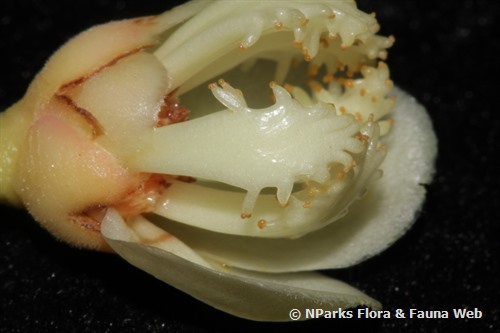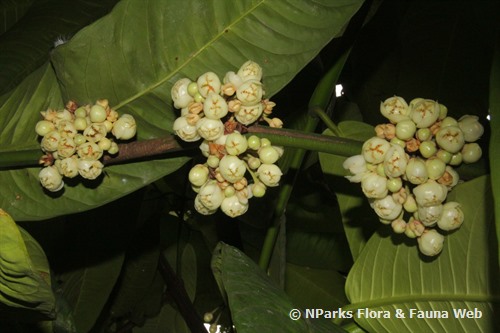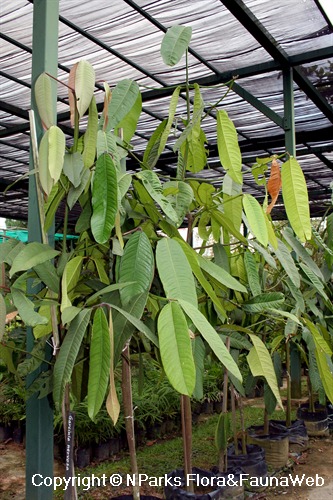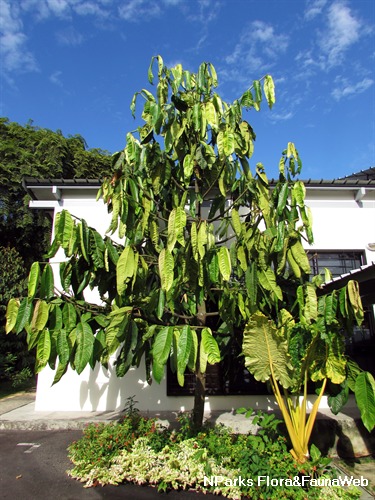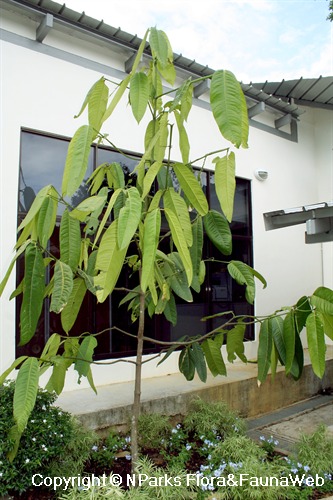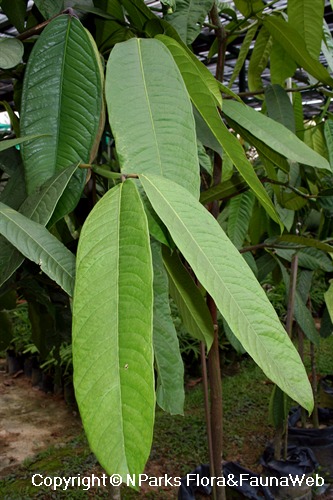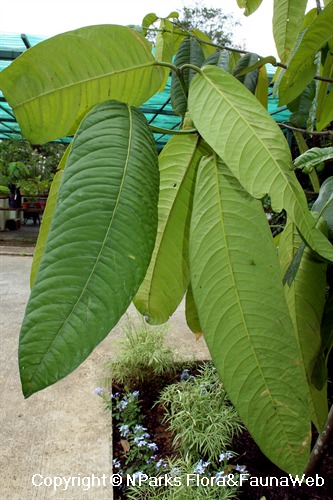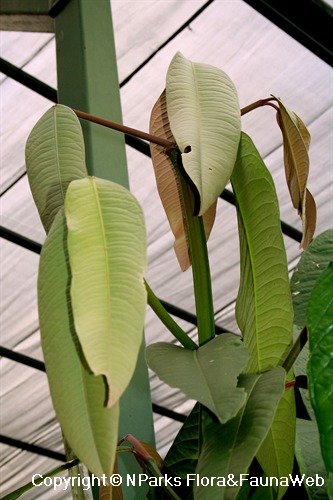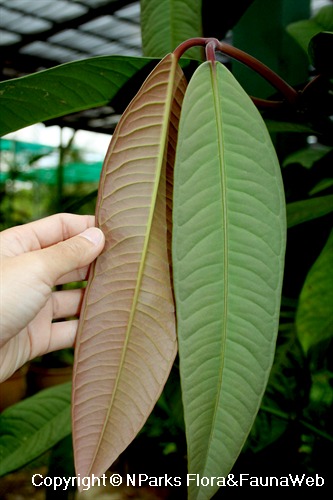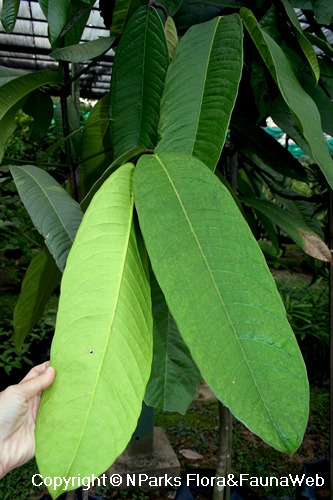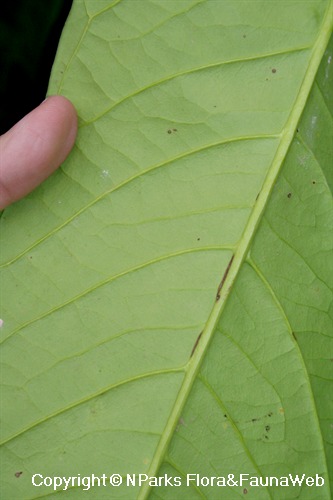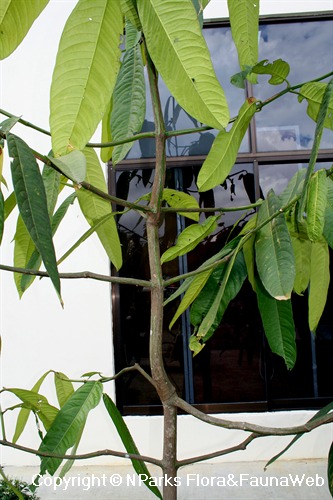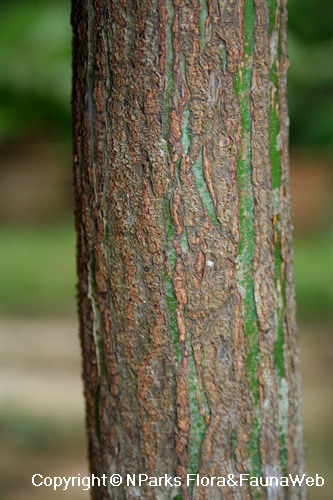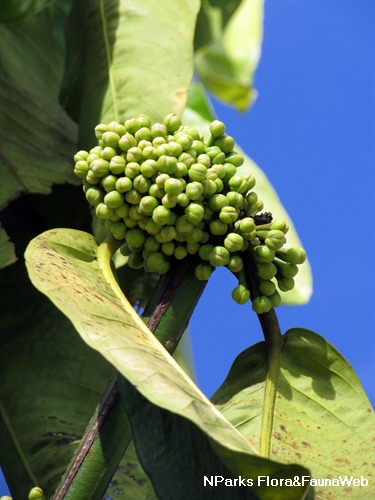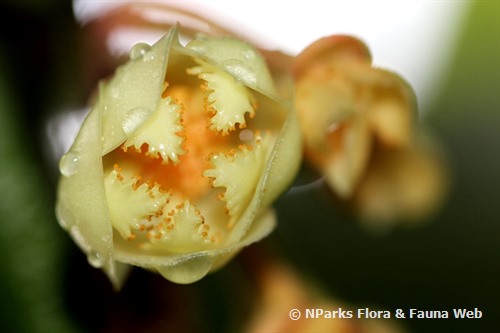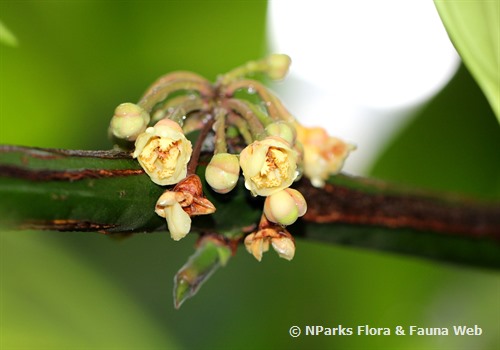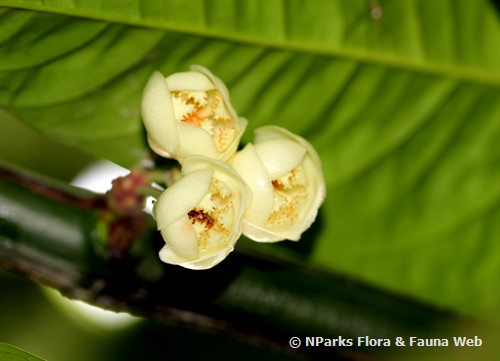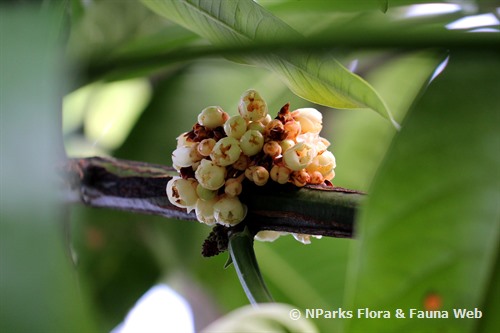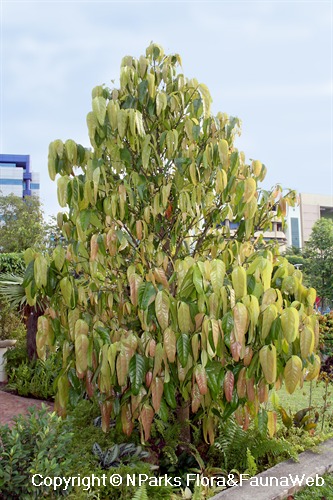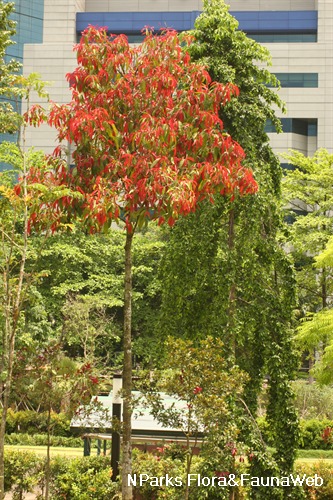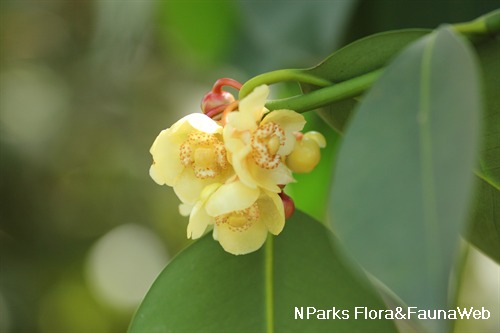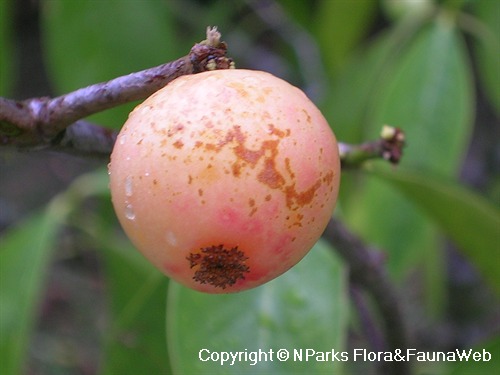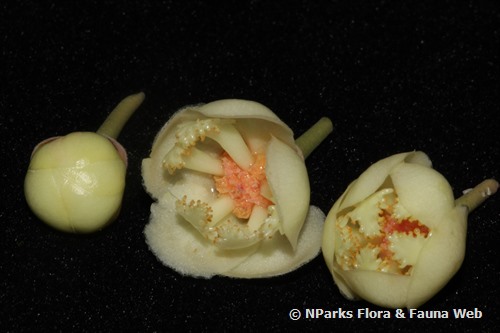
Back
Garcinia nervosa Miq.
| Family Name: | Clusiaceae (Guttiferae) |
| Synonyms: | Garcinia spectabilis, Garcinia andersonii |
| Common Name: | Pear Mangosteen, Pokok Lapan Taun, Kandis Gajah, Asem Kandis, Mundu, Asam Garam |
Name
Classifications and Characteristics
| Plant Division | Angiosperms (Flowering Seed Plants) (Dicotyledon) |
|---|---|
| Plant Growth Form | Tree (Medium (16m-30m)) |
| Lifespan (in Singapore) | Perennial |
| Mode of Nutrition | Autotrophic |
| Plant Shape | Conical, Open, Irregular |
| Maximum Height | 30 m |
Biogeography
| Native Distribution | Sumatra, Peninsular Malaysia, Singapore, the Philippines, and Borneo |
|---|---|
| Native Habitat | Terrestrial (Primary Rainforest, Riverine, Secondary Rainforest, Freshwater Swamp Forest) |
| Preferred Climate Zone | Tropical |
| Local Conservation Status | Native to Singapore (Critically Endangered (CR)) |
Description and Ethnobotany
| Growth Form | It is an evergreen medium-large, mid-canopy rainforest tree, up to 30 m height. Crown conical, relatively open, with tiered horizontal branching. Branches typically restricted to upper parts of crown in wild trees. All parts of plant exude yellowish latex when bruised. |
|---|---|
| Foliage | Its opposite, stoutly stalked leaves have leathery leaf blades that are oblong, with strongly-ribbed abaxial veins, and 22–60 by 9–25.5 cm. Young leaves reddish, maturing to whitish-green, then green. |
| Stems | Strongly 4-ridged. |
| Flowers | Its flowers grow in large clusters, with separate male and female flowers. Each flower is small, with creamy-white fleshy petals, scented like lime or sour milk, opening at dusk, The female flowers more strongly-scented, with sterile stamens and producing lots of honey. |
| Fruit | Its fruits are pear-shaped to round, to 8 cm wide, ripening from green to blotchy or pale yellow and contain up to five red seeds in the white pulp. |
| Habitat | It grows in riverine and seasonally-swampy areas in lowland rainforests, on relatively flat terrain with poorly-drained alluvial soils, sometimes found in coastal forests. |
| Associated Fauna | Its flowers are pollinated by insects. Its fruits are eaten by birds and small mammals. |
| Cultivation | Withstands shade when young. More tolerant of waterlogged acidic sites than most other Garcinia species, but appears to dislike lateritic soils. Propagate by air-layering and seeds (if available). |
| Etymology | Genus epithet 'Garcinia' named after French botanist, naturalist and plant collector, Laurent Garcin (1685-1752), who travelled extensively across India, where the genus is well-represented. Species epithet 'nervosa' means 'conspicuous veins', a reference to the plant's foliage. |
| Ethnobotanical Uses | Edible Plant Parts : Edible Fruits Food (Fruit or Vegetable): Pulp edible, soft and sour. (Herb or Spice) Medicinal: Antioxidant biflavonoids found in fruits and seeds. Leaves pounded into paste, boiled in coconut oil, and rubbed onto body and joints for pain relief. Timber & Products: Wood pale brown, hard, fairly durable if sheltered from outdoor elements. Branches used to make canoe paddles. Split stems used to construct framework for huts. Wood used for posts, beams and roofing. |
Landscaping Features
| Landscaping | It has a sparse crown with extremely large, elongated leathery leaves, making it suitable for large gardens or parks. It is considered the “noblest species of the genus” by the botanist J. D. Hooker. It is a tree suitable for gardens, parks and roadsides. |
|---|---|
| Desirable Plant Features | Ornamental Foliage, Ornamental Fruits, Fragrant (Flowers) (Day) |
| Landscape Uses | General, Suitable for Roadsides, Parks & Gardens, Riverine |
| Thematic Landscaping | Naturalistic Garden |
| Plant & Rootzone Preference or Tolerance Remarks | Does not like lateritic soils |
Fauna, Pollination and Dispersal
| Fauna Pollination Dispersal Associated Fauna | Bird-Attracting |
|---|---|
| Pollination Method(s) | Biotic (Fauna) |
| Seed or Spore Dispersal | Biotic (Fauna) |
Plant Care and Propagation
| Light Preference | Full Sun, Semi-Shade |
|---|---|
| Water Preference | Moderate Water, Lots of Water |
| Plant Growth Rate | Moderate |
| Rootzone Tolerance | Fertile Loamy Soils, Well-Drained Soils, Waterlogged Soils (Drains Site), Moist Soils |
| Maintenance Requirements | Moderate |
| Propagation Method | Seed, Grafting, Air-Layering |
Foliar
| Foliage Retention | Evergreen |
|---|---|
| Mature Foliage Colour(s) | Green |
| Mature Foliage Texture(s) | Leathery, Raised / Sunken Veins, Thick |
| Prominent Young Flush Colour(s) | Red |
| Foliar Type | Simple / Unifoliate |
| Foliar Arrangement Along Stem | Opposite |
| Foliar Attachment to Stem | Petiolate |
| Foliar Shape(s) | Non-Palm Foliage (Oblong) |
| Foliar Venation | Pinnate / Net |
| Foliar Margin | Entire |
| Foliar Apex - Tip | Acute |
| Foliar Base | Rounded / Obtuse |
| Typical Foliar Area | Macrophyll ( 182.25cm2 - 1640.25 cm2 ) |
Non - Foliar and Storage
| Trunk Type (Non Palm) | Woody |
|---|---|
| Bark Colour(s) | Grey-brown |
| Mature Bark Texture | Cracked |
| Stem Type & Modification | Woody |
| Root Type | Underground (Tap Root, Fibrous Root) |
Floral (Angiosperm)
| Flower & Plant Sexuality | Unisexual Flowers , Dioecious |
| Flower Colour(s) | Cream / Off-White |
|---|
| Flower Grouping | Cluster / Inflorescence |
| Flower Location | Axillary |
| Flower Symmetry | Radial |
| Flower Size - Remarks | Small, cauliflorus |
| Ovary Position | Superior / Hypogynous |
| Flowering Period | Rarely |
| Flowering Opening Time | Night (dusk to dawn) |
| Flowering Habit | Polycarpic |
Fruit, Seed and Spore
| Mature Fruit Colour(s) | Yellow / Golden |
|---|---|
| Fruit Classification | Simple Fruit |
| Fruit Type | Fleshy Fruit , Berry |
Image Repository
Others
| Master ID | 11598 |
|---|---|
| Species ID | 3321 |
| Flora Disclaimer | The information in this website has been compiled from reliable sources, such as reference works on medicinal plants. It is not a substitute for medical advice or treatment and NParks does not purport to provide any medical advice. Readers should always consult his/her physician before using or consuming a plant for medicinal purposes. |

